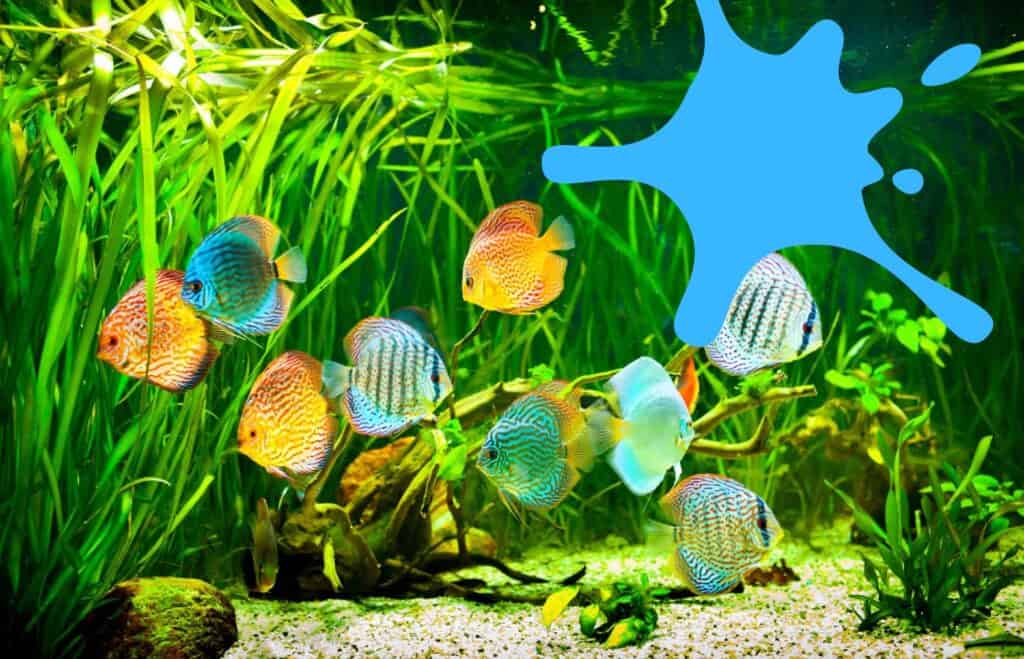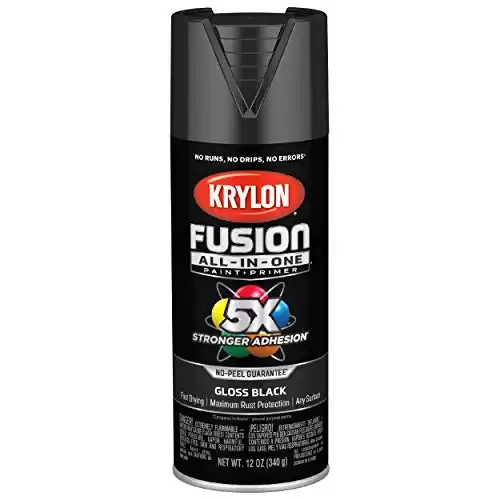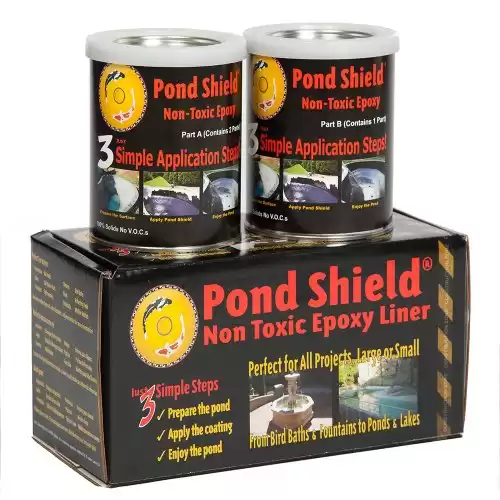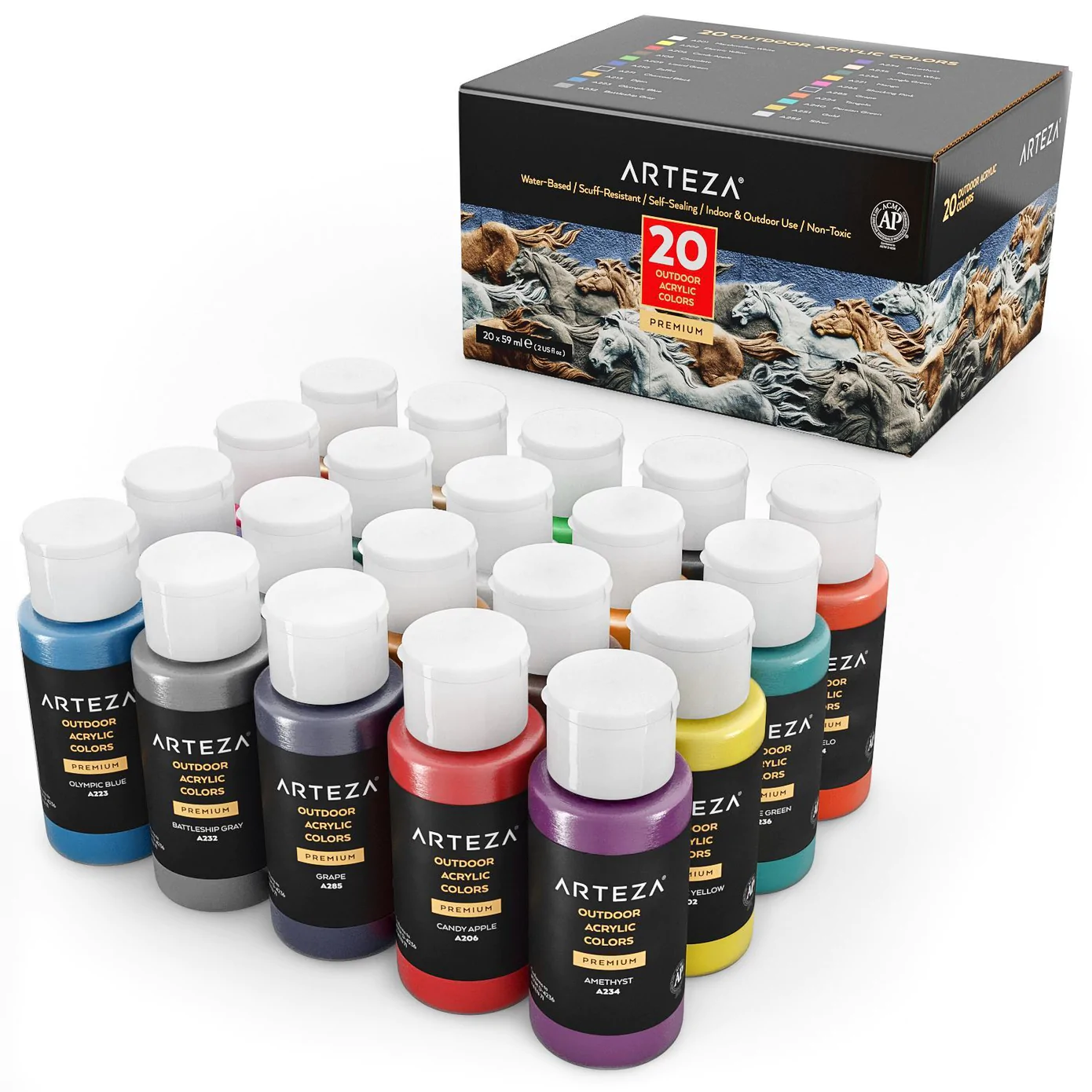There might be times when you want to use paint inside and outside your fish tank. But you need to know that the paint you’re using is safe for your fish and living plants.
|
Primary Rating:
4.6
|
Primary Rating:
4.0
|
Primary Rating:
5.0
|
The wrong kind of paint can chemically react with the fish tank water and can also cause the glass viewing panes to warp and crack which is potentially dangerous for you and your fish.
Read this comprehensive buyer’s guide to our reviews of the best aquarium-safe paint and more!
3 Best Aquarium Safe Paints 2022
We want to help you make your aquarium a safe, healthy place where your fish can thrive.
If you need to use paint to make your tank more aesthetically pleasing, use aquarium-safe paint, such as these listed below.
Krylon K02778007 Fusion All-in-One Spray Paint
- GLOSS BLACK COLOR – Black gloss spray paint offers a modern, sleek finish to any project. Black is a classic color spray paint that should be kept on hand with DIY supplies and in a craft or tool kit.
Features:
- Quick-drying spray paint
- Excellent adhesion to most surfaces
- Safe for the environment
Spray paint is an excellent product choice as you can apply it to pretty much any surface. So, if you want a highly efficient way to paint your aquarium walls, Krylon Fusion All-in-One spray paint is a great pick.
This paint is formulated to stick to a plastic surface, making it ideal for use on acrylic tanks. The paint is flexible and quick-drying, producing an attractive matte finish without needing extra coats or additional topcoats.
The paint produces excellent coverage, and many users reported that one single coat was typically adequate to achieve the desired result. This product is environmentally safe, non-toxic, and free from dangerous chemicals that could harm you or your fish.
This spray paint is quick-drying and is available in various colors and finishes. You can even mix the colors to achieve the perfect hue! Peeling paint is a common issue in many fish tanks. However, this paint will totally eliminate that problem.
What We Like:
- Easy to use
- Quick-drying
- Available in a wide range of colors and finishes
Room for Improvement
- Not designed for aquarium use but non-toxic and safe
Pond Armor
- Specifically designed for underwater use and to be non toxic and fish and plant safe
- Self priming formula allows for reliable adhesion for a finished surface that is easy to maintain
- Can be put into service in as little as 24 hours
- Can be applied to any constructed surface made of wood metal or stone as well as most plastics and other coatings
Features:
- Two-part epoxy paint
- Excellent coverage, strong adhesion, durable
- Wide range of colors and finishes
Pond Armor is a very affordable paint that’s safe for use on fish tanks. This is a two-part epoxy paint available in many different colors and finishes that you can combine to get the perfect shade.
This excellent product gives you superb coverage, strong adhesion, and long-lasting durability. The two-part paint system ensures that your aquarium will last many years without showing any deterioration in performance or appearance. You can use this product on glass, metal, and wood, making this an ideal choice for touching up old tank decorations and making new ones.
The product has a thick consistency, which ensures smooth application and helps to guard against dripping and peeling. You can apply this paint in warm or cold conditions, and it withstands the most extreme weather, so you can be sure your fish tank will continue looking good, whatever happens.
What We Like:
- Weatherproof
- Excellent adherence
- Wide range of colors and finishes
Room for Improvement:
- Very thick consistency can make application tricky
Arteza Outdoor Acrylic Paint
- Scuff-Resistant - Create works of art for both indoors and outdoors
- High Viscosity Acrylics - The thick, smooth consistency allows you to create textures with your brush or palette knife
Features:
- Non-toxic
- Water-based acrylic paint
- Adheres to glass and plastic
If you want to create color and excitement in your tank, Arteza Outdoor Acrylic Paint is definitely worth considering.
This excellent quality, water-based paint is designed on various surfaces, including glass and plastic fish tanks. So, if you want to paint your aquarium’s back wall a bright color to contrast with your fish and planting, this product is a great choice.
The paint is easy to apply, going on smoothly to create a thick, solid coat that won’t crack or drip. Thanks to its excellent adhesion, the paint won’t peel or fade when submerged, and it’ll look good for many years.
If you decide to use the paint on the outside of your tank or around your pond, you’ll be pleased to hear that it dries very quickly to a high-gloss finish formulated to withstand even the toughest weather conditions.
The sky’s the limit when it comes to color choice, and the paint is totally safe for use with fish and other aquatic livestock.
How To Choose Aquarium-Safe Paint
When shopping for aquarium paint, it’s essential that you know what to look for. If you make a mistake, you could finish up poisoning your fish, so making the right choice is crucial.
Ingredients
There are a few types of paints that are marketed as being safe for use in aquariums. Generally, those paints are typically water-based or latex-based acrylic paints, both of which are considered aquarium-safe.
Chemicals To Avoid Include:
- Zinc chromate
- Ethylene glycol
- Lead
- Metallic salts
Of those chemicals, lead is highly toxic and is one of the deadliest chemicals you’ll find in a home. So, double-check any product you’re about to buy and ensure it’s free from any of those chemicals.
Remember that even if the paint doesn’t release those chemicals once it’s dry, that can still be a problem if the aquarium becomes damaged and the paint cracks or starts to peel.
Paint Types
Paint is generally classified on its product type. The main paint types considered safe for aquariums are non-toxic acrylic, epoxy, latex, and shellac. Of those, acrylic and latex paints are widely regarded as the safest because they don’t contain harmful chemicals that could leach into your aquarium water.
Although oil-based paints might appear to be a similar type of liquid paint, these paints often contain toxic chemicals that are very harmful to fish. Never use oil-based paints in an aquarium.
That said, you can generally safely use a rubber-based or latex paint formulated with an oil-based primer. Non-toxic epoxy paint is also considered aquarium-safe for exterior use, provided the paint won’t be submerged in water.
Never use mold-resistant paint in your aquarium. Mold-resistant paint contains fungicides such as thiabendazole, which is dangerous to fish and other aquarium residents.
Durability
The terms “fade resistance” and “lightfastness” refer to how long the paint is able to remain undamaged by sunlight.
If the paint is not chemically resistant to the sun’s UV rays, it will gradually start to break down and fade. Generally, latex and acrylic paints are considered to be safe for aquariums and highly lightfast.
Another important consideration when choosing paint for your aquarium is its ability to resist damage from normal wear and tear. Thin, watery paints are more prone to damage over time, this can be a hazard for fish that might mistake the paint chips for food, leading to digestive problems and even death.
Thick waterproof paint with higher viscosity is less likely to sustain that damage and is considered safer for aquariums.
Another crucial durability aspect to look out for is the paint’s ability to resist chemicals such as aquarium salt and oil. If you’re going to use paint inside your fish tank, ensure it can withstand any potential chemical reactions that might take place between the water and aquarium salt if you use it.
How It Looks
Of course, one of the most important considerations when choosing aquarium paint is its appearance.
The color you choose depends on what you want the paint to do.
For example, acrylic paintboxes can be a good choice if you want a colorful paint selection to touch up or decorate tank decorations. However, if you want to paint the back of your aquarium to conceal the wall and wires behind it, black or even cream might be what you’re looking for.
The paint’s finish can also greatly impact the look of your fish tank. Matte paints are great for producing a smooth, non-reflective finish, whereas a glow-in-the-dark finish can be a wonderful way to show off your fish.
Is Paint Safe for Reef Tanks?
When it comes to aquarium-safe paints, reef and marine tanks are a slightly different proposition from freshwater setups. Unfortunately, most paints gradually dissolve in saltwater, and that’s deadly for your fish.
If you really must use paint inside a saltwater tank, double-check that the product you’re considering is resistant to salt and won’t degrade if exposed to saltwater.
How To Paint Aquarium Backgrounds
The most popular painting project for fish tanks is adding a background.
Painting a simple colored background is a practical, fun way of sprucing up a tired-looking fish tank. It’s also much easier to paint a background than to try to attach a tape-on background that you bought from your local fish store. Those backgrounds that looked promising and attractive in the fish store are now just laminated sheets of bubbled and crinkled paper stuck to the rear viewing pane.
The main issue is that you can never get laminated, tape-on backgrounds totally flush with the glass so that they look professional. Painting a background is much easier and more effective.
So, here’s how to paint an aquarium background on a glass fish tank.
How To Do It
Painting outside your aquarium viewing pane is not a difficult project, and you can typically complete it in only a day.
Create your background by painting the outside of the tank, not the inside. That way, you know that you won’t accidentally poison your fish.
If you’re only applying paint to the outside of the glass, you have a wide choice of paints to choose from, and you can use any color you want.
What You’ll Need
Here’s what you’ll need to paint your aquarium background:
- Empty fish tank
- Painter’s tape
- Rubbing alcohol
- Newspaper
- Paint
Aquarium Background Painting Process
Start by gathering together everything you need before you begin so that you don’t have to break off what you’re doing mid-task to get something.
We recommend working on this project outside or in a well-ventilated garage, especially if you’re using spray paint.
- Take a towel and rubbing alcohol and use it to clean the area of glass you want to paint. Rubbing alcohol removes grease and dirt on the surface, enabling the paint to adhere to the glass properly.
- Next, cover all the aquarium parts you don’t want to paint with newspaper and fix it to the tank with painter’s tape. Ensure that everywhere is covered, including the open end of the tank, so that no paint gets inside.
- Now, you’re ready to apply the paint onto the glass. It’s better to put on several light coats of paint than one thick one that will probably run and drip. So, keep the spray light so that you end up with an even coating, and repeat the process as many times as necessary for good coverage.
- The paint should be allowed to dry for one day. After that, remove the tape, wash out the inside of the tank to remove dust, and continue setting up your tank.
When the painting project is complete, your fish tank will have a smart, evenly covered background that displays your aquascaping to the best effect and really makes your fish’s colors pop!
How To Spray Paint Plastic Aquarium Decorations
Over time, plastic or resin aquarium decorations can lose their luster and look drab and tatty. Many people simply discard old ornaments and replace them with new ones. However, if you have a favorite item of tank decor that you want to keep, why not freshen it up with a new coat of paint?
- Start by preparing the surface you want to repaint. That’s important to ensure that the paint doesn’t start to flake in the future.
- Use rubbing alcohol to clean the surface as described above.
- Now, take a piece of 600-grit sandpaper and wet-sand the surface of the plastic decoration. When the plastic surface appears hazy, and all the shine has gone, you’re ready to paint it.
- Use more alcohol to clean the scuffed plastic again to remove any dust and grit that could prevent the paint from sticking to the surface. Allow the ornament to dry fully.
- Next, apply two or three coats of your chosen paint. If that doesn’t completely cover the original paint color, keep building paint layers until you achieve the desired effect.
- If there’s a particular area on the decoration that you want to define more clearly, spray some of your paint into a container, and use a fine paintbrush to apply the paint.
- Allow the paint to dry fully, as per the manufacturer’s instructions.
- Before you can put the decoration into your tank, you need to seal it. Most hobbyists use a clear 2-part epoxy to give a durable effect. If using an acrylic resin-based varnish, choose the UV-resistant one so that your paintwork doesn’t fade.
Before putting the ornament back in your aquarium, rinse it under the tap to remove any dust and loose product.
Final Thoughts
Did you enjoy our guide to choosing aquarium-safe paint? If you found the article helpful, please take a moment to share it.
If you decide to paint the outside of your aquarium, touch up some old decorations, or make new ones, you’ll need aquarium-safe paint. Make sure the paint you choose doesn’t contain harmful chemicals, such as zinc chromate, lead, metallic salts, or ethylene glycol, that could degrade and poison your fish.
You also must choose a paint that won’t fade or flake off. If the paint flakes, your fish might mistake that for fish food and eat it, leading to potentially fatal digestive problems.
If you painted your aquarium, we’d love to hear about your project! Tell us how it went in the comments box below.





